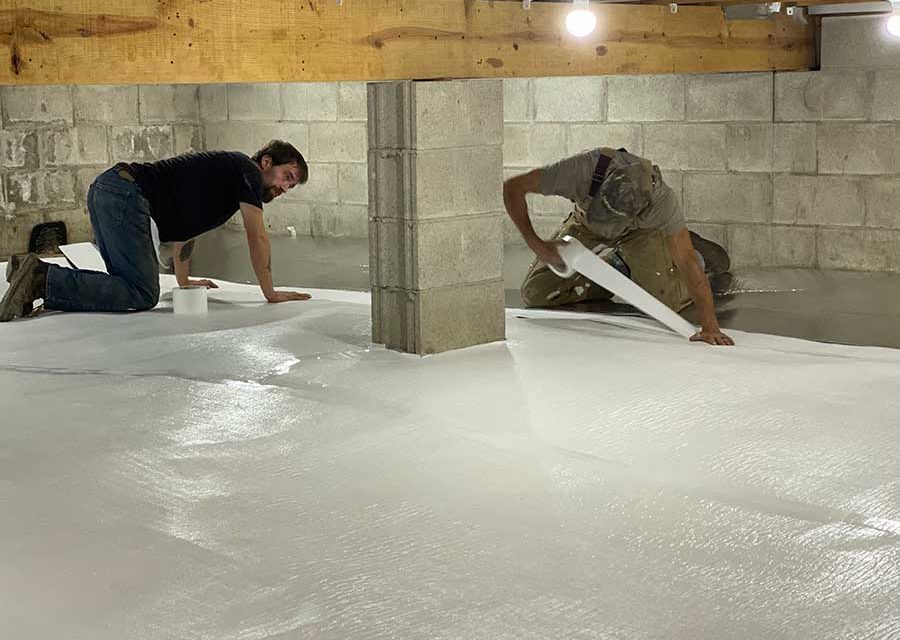Waterproofing your basement and crawlspace is one of the most important things you can do to protect your home from moisture, mold, and structural damage. Whether you’re dealing with small amounts of dampness or severe water intrusion, waterproofing these areas will help improve the health and comfort of your living environment and maintain your home’s value.
Assess Your Basement and Crawlspace
Before carrying out any basement or crawlspace waterproofing methods, you should assess their condition to identify problem areas. Start by inspecting for signs of moisture, such as water stains, mold, mildew, or condensation on the walls and floors. Check for cracks in the foundation, walls, and floor, and don’t forget to look at areas around windows and vents where moisture might be seeping in.
Another important thing is testing the humidity levels using a hygrometer. If the humidity level in your basement or crawlspaces is over 50%, you are at risk of mold growth and dampness. For the most thorough assessment, find the best basement waterproofing company in your city and let them handle your basement and crawlspace issues professionally and safely.
Waterproofing Your Basement
Once you’ve identified potential problem areas in your basement, it’s time to tackle waterproofing. Here are the essential methods for keeping your basement dry and protected.
- Sealing Cracks and Leaks: Cracks in your basement walls or floor are often the entry point for water. Use hydraulic cement or specialized waterproof sealants to fill and seal any cracks. This simple step prevents water from seeping into your basement and causing damage.
- Installing Interior Drainage Systems: A professional interior drainage system installation might be necessary for basements with consistent water intrusion. This involves installing a perimeter drain tile system that channels water away from your basement and directs it to a sump pump. The sump pump then removes the water from your home, preventing flooding.
- Applying Waterproof Coatings: Another effective method for waterproofing your basement is applying a waterproof coating to the walls and floors. These coatings are a barrier, preventing water from seeping through the foundation. In addition, consider having vapor barriers professionally installed to block moisture and prevent dampness from accumulating.
- Improving Ventilation: Proper ventilation helps reduce moisture buildup in your basement. Ensure your basement is well-ventilated by installing or upgrading vents or using exhaust fans and dehumidifiers.
Waterproofing Your Crawlspace
Crawlspaces, like basements, are highly susceptible to moisture problems. Here’s how to go about waterproofing your crawlspace:
- Encapsulation Process: Encapsulating your crawlspace is one of the most effective waterproofing methods. This process involves clearing debris, covering the gravel floor with a durable and puncture-resistant vapor barrier, and sealing the crawlspace walls to prevent moisture from entering. It’s important to prioritize safety and effectiveness forcrawlspace waterproofing projects, and the best way to do that is to seek professional services.
- Addressing Crawlspace Ventilation: Ventilation is just as important for crawlspaces as it is for basements. Poor ventilation can trap moisture, leading to mold issues and structural damage. Consider installing crawlspace vents or using dehumidifiers to control the moisture levels and improve air circulation in your crawlspace.
- Insulating and Sealing: Insulating your crawlspace walls and sealing cracks and gaps in the exterior of your crawlspace will block any water from entering, further reducing the chances of water damage.
- Installing a Drainage System: Crawlspaces can also benefit from a drainage system. Perimeter drains and sump pumps can be installed to collect and remove water before it can cause damage. While it might be tempting to carry out these waterproofing processes on your own, it’s always best to consult with experienced professionals, especially for more severe issues.
Exterior Waterproofing Solutions
While interior waterproofing handles moisture inside, exterior solutions like installing exterior foundation membranes prevent water from seeping into your basement or crawlspace. These membranes act as barriers against moisture from heavy rain or poor drainage. Additionally, ensure proper grading to direct water away from the foundation with landscaping features like French drains. Lastly, maintain your gutters and downspouts to keep water at least 6-10 feet away from your home, preventing foundation issues.
Professional Help vs. DIY Waterproofing
While homeowners can handle some waterproofing tasks, certain issues require professional intervention. If your home has significant foundation cracks, extensive water damage, or severe flooding problems, it’s best to call a professional. Find the best basement waterproofing company in your city by seeking recommendations and checking certifications and client reviews. These companies have the tools and expertise to provide long-term solutions, such as installing waterproof membranes, sump pumps, or complex drainage systems.




